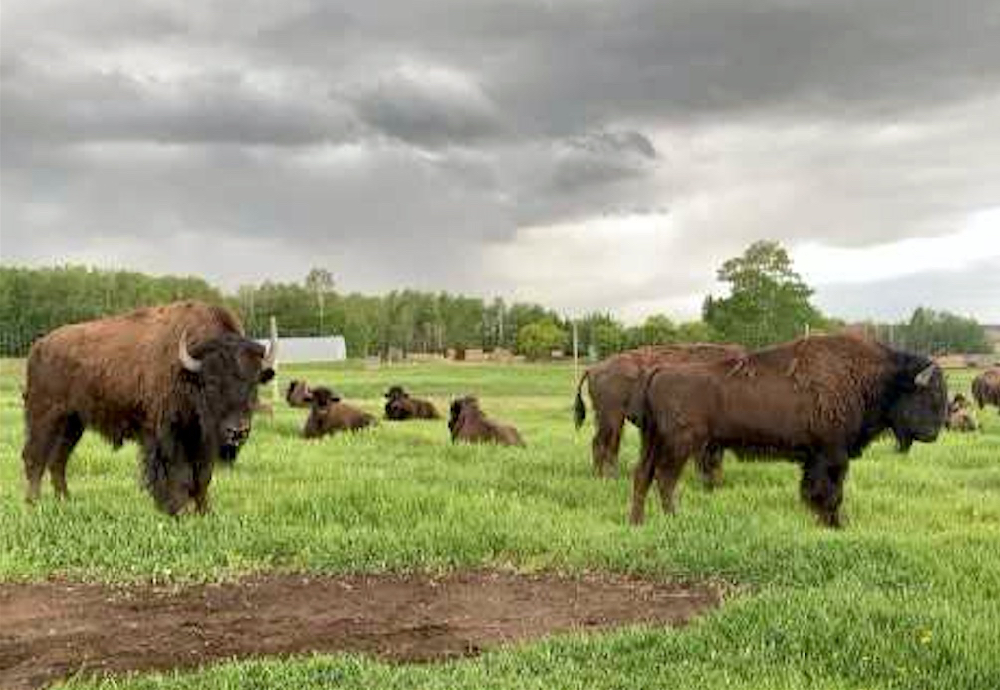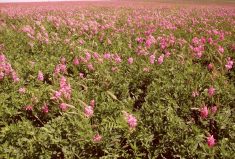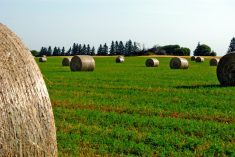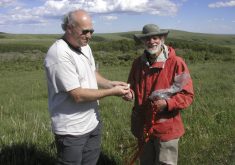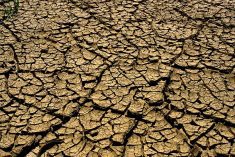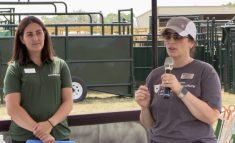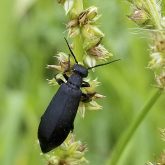Some areas in Western Canada welcomed rain recently. But overall, the Prairies are facing a 200-millimetre moisture deficit, Environment Canada estimates. To turn around the growing season, timing of rain is at least as important as volume, Marlo Glass reports in MarketsFarm. Drought-stricken areas will need a rainy day every week or 10 days throughout the growing season to sustain plant growth, she reports.
Meanwhile, in Ontario, producers are haying and wrapping up seeding in wet conditions.
Read Also

Why post-drought pasture management matters for beef farmers
Pasture management is always important, but it is especially important following a drought. During these challenging periods, pastures may suffer…
Alberta
Bison producer Brian Cunningham reports that the Pigeon Lake area in Alberta saw three inches of rain in May and two inches in June. Thanks for the update and the photo, Brian. (see photo at top)
A dry spring, cooler temperatures, and previous dry seasons have taken their toll on forages, and it is likely too late for hay to recover in many regions, the Alberta Crop Report for June 18 notes. Areas in western and central Alberta had received more normal rainfall levels recently, as much as 100 mm. Overall, tame hay was rated as 16 per cent poor, 37 per cent fair, 45 per cent good and two per cent excellent.
Despite recent rain, hay and pasture are struggling in central Alberta. Some counties were still dealing with dry conditions, but the forecast is likely to provide relief. Tame hay conditions in central Alberta were reported as 46 per cent good, 28 per cent fair and 26 per cent poor.
Pasture and tame hay have improved slightly in the northeast and northwest. In northwestern Alberta, 62 per cent of tame hay was rated good, with 35 per cent fair and three per cent poor. By contrast, only 26 per cent of tame hay in the northeast was rated as good, and three per cent excellent. Another 48 per cent of northeastern hay was rated fair and 23 per cent as poor condition.
The Peace region was still looking for rain, especially in the northern part of the region. Most counties received scattered showers, but dry conditions and wildfire smoke have slowed crop growth. In the Peace, three per cent of tame hay rated excellent, 38 per cent as good, and the bulk of it (49 per cent) rated fair. Ten per cent rated poor.
In the south, the report states that “hay and pastures are not in good shape.” Just under half of tame hay growth was rated good, four per cent excellent, 31 per cent fair and 16 per cent poor. Most counties have been dry.
Video: Three tips on managing grazing in a drought
Saskatchewan
Areas in west central Saskatchewan saw as little as one mm of moisture the second week of June, while Outlook received 45 mm. Only three per cent of hayland and pasture topsoil moisture was rated adequate, and the other 97 per cent was short or very short.
Much of the east central region received significant rain, but more was needed. The Goodeve area won the rain lottery that week, seeing 77 mm. Topsoil moisture conditions had improved, but 67 per cent of hayland and pasture was rated short or very short.
In the southwest, rainfall ranged from nil to the 29 mm in the Webb area. More rain was needed soon to grow crops, hay and pasture. Hayland and pasture topsoil suffered, with 93 per cent rated short or very short.
Most of the southeast reported rainfall, ranging up to 47 mm seen in the Tantallon area. Hayland and pasture topsoil moisture was rated as 35 per cent adequate, and the balance short or very short. West of Moose Jaw, 73 per cent of hayland and pasture had very short topsoil moisture.
Most areas in the northeast saw rain, with Melfort receiving 90 mm. Hayland and pasture topsoil moisture was rated as two per cent surplus, 71 per cent adequate and 27 per cent short or very short.
Moisture was still needed in much of the northwest region, but some areas received rain, including the Neilburg area, which topped 26 mm. Rain bumped 50 per cent of hayland and pasture topsoil moisture to an adequate rating, but left 49 per cent at short or very short.
Manitoba
Overall, Manitoba farmers saw slightly warmer daytime temperatures, which encouraged crop growth, the Manitoba Crop Report from June 18 notes.
The southwest generally saw 25 mm or more of rain, with Ninette, Souris and Lenore reporting 40 to 60 mm. Pastures will benefit, but previously overgrazed pastures were slow to rebound. Younger hay stands will probably benefit more than older stands.
The northwest saw minimal rainfall, with the exception of the Roblin area, which saw 13 to 39 mm. Hay yields were predicted to be zero to very low. Older fields had no new growth for cutting. Most cattle were on pasture, but without more rain would likely have a very short grazing season.
In the central region, rainfall ranged from five mm around Austin to 45 mm around Cartwright. Newer, fertilized alfalfa fields in the Green-Gold hay quality monitoring program were growing well. But older hay fields with more grass were well below average for growth. Heavy rain in the south will help pasture but came too later for the first cut. Some hay yields were estimated to be a half to one round bale per acre.
Rainfall in eastern Manitoba ranged from two to 15 mm. Hayfield conditions were rated 50 per cent fair and 50 per cent poor to very poor. Pasture was rated as 40 per cent fair, the balance being poor to very poor. Recent rains did improve pasture growth. Haying has started, and the first alfalfa fields have yields 50 per cent of normal.
Most areas in the Interlake region saw little rainfall. The Stonewall-Balmoral area received 10 to 15 mm. Topsoil moisture was rated as 70 per cent short and 30 per cent very short. Some oat and barley acres remained to be seeded, and would go in as grain or feed as needed. Older hay stands were being renovated. Pastures were two to three weeks behind. First cut of dairy hay was underway, with yields expected to be below normal.
Ontario
Ontario’s June 17 Field Crop Report notes that the first hay cut is underway. Most of the hay was being harvested as haylage due to wet weather. Yields ranged from below average to average, and quality was still unknown for the most part.
Some livestock producers were planting silage corn for forage. The Field Crop Report reminds producers that alternative forage crops generally take 45 to 60 days from planting to harvest, depending on the crop.
Most grain corn planting has wrapped. Some regions with heavy clays saw less than 10 per cent of intended acres planted to corns, while others planted 90 per cent of intended acres to corn. Some farmers in areas with high heat units still intended to plant some grain corn before forecasted rain on June 20. There was also still some silage corn to be seeded.
Where did all the DON corn go?
Do you have a current photo illustrating the pasture or feed situation in your area that you’d like to share? Send it to [email protected] (subject line: Feed Watch) or tweet it to @LtoG. Be sure to share your name, location and some information about the situation in your region.


